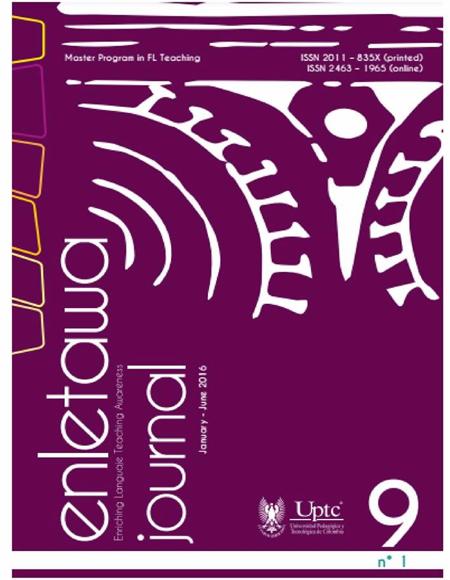Involving University Students in Intercultural Communicative Competence Activities through the Use of Cultural Products and Practices

Resumen
This document presents the findings of a research study developed with elementary level of English students from Instituto Internacional de Idiomas at Universidad Pedagógica y Tecnológica de Colombia. A series of pedagogical interventions were designed, in response to an initial diagnostic, which explored students’ Intercultural Communicative Competence (ICC) taking as referent Byram’s model (1997). Using the framework of qualitative action research, class activities, reflective journals and focus groups interviews were used to obtain the necessary information in order to reflect upon what students expressed regarding the ICC. The study revealed three categories: cultural recognition, cultural experience and cultural reaction. Moreover, the results indicated that students were in an early stage of their ICC which was fostered through class activities. They understood the purpose and usefulness of the ICC. In addition, they were open and interested in including culture and ICC activities in the EFL classroom.Palabras clave
Language, Culture, Cultural Products, Cultural Practices and Intercultural Communicative Competence
Citas
- Abdollahi-Guilani, M., Yasin, M. S. M., Hua, T. K., and Aghaei, K. (2012). Culture-Integrated Teaching for the Enhancement of EFL Learner Tolerance. Asian Social Science, 8 (6),115. DOI: https://doi.org/10.5539/ass.v8n6p115
- Burns, A. (2010). Doing action research in English language teaching: A guide for practitioners. New York: Routledge. DOI: https://doi.org/10.4324/9780203863466
- Byram, M. (1997). Teaching and assessing intercultural communicative competence. Clevedon: Multilingual Matters.
- Byram, M., Gribkova, B., and Starkey, H. (2002). Developing the intercultural dimension in language teaching. Strasbourg: Council of Europe, 41.
- Common European framework of reference for languages: Learning, teaching, assessment. (2002). Strasbourg: Council of Europe Publ.
- Hall, E. T. (1959). The silent language (Vol. 3, p. 1959). New York: Doubleday.
- Halverson, R. J. (1985). Culture and vocabulary acquisition: A proposal. Foreign Language Annals, 18 (4), 327-332. DOI: https://doi.org/10.1111/j.1944-9720.1985.tb01810.x
- Hesar, M., Konca, M., and Zarfsaz, E. (2012). Why and how to apply culture in an EFL classroom. In 2012 International conference on language, medias and culture proceedings (Vol. 33, pp. 68-72).
- Janesick, V. J. (1998). “Stretching" exercises for qualitative researchers. Thousand Oaks, CA: Sage.
- Kemmis, S., and McTaggart, R. (1988). The action research planner. Geelong, Victoria: Deakin University Press.
- Klein, F. (2004). Culture in the foreign language classroom: Teachers’ beliefs, opportunities and practice. (Doctoral dissertation, University of Minnesota). Dissertation Abstracts International, A: The Humanities and Social Sciences, 64 (4), Oct, 1235-A, 319.
- Krueger, R. A. (1997). Moderating focus groups. Thousand Oaks: Sage DOI: https://doi.org/10.4135/9781483328133
- Lafayette, R. C. (1988). Integrating the teaching of culture into the foreign language classroom. In A. J. Singerman (Ed.), Towards a new integration of language and culture (pp. 47-62). Northeast Conference on the Teaching of Foreign Language. Middlebury, VT: Northeast Conference.
- Lusting, M., Koester J. (1999). Intercultural competence: Interpersonal communication across cultures. NY: Addison-Wesley Longman.
- Mahmoud, M. A. (2015). Culture and English Language Teaching in the Arab World. Adult Learning, 26(2), 66-72. DOI: https://doi.org/10.1177/1045159515573020
- Ministerio de Educación Nacional. (2006) Estándares Básicos de Competencias en Lenguas Extranjeras: Inglés. Formar en lenguas extranjeras: Inglés¡ el reto. Bogotá́: IPSA
- Moran, P. R., and Lu, Z. (2001). Teaching culture: Perspectives in practice. Boston, MA: Heinle and Heinle.
- Ortlipp, M. (2008). Keeping and using reflective journals in the qualitative research process. The qualitative report, 13 (4), 695-705.
- Paige, R. M., Jorstad, H. L., Siaya, L., Klein, F., and Colby, J. (2000). Culture learning in language education: A review of the literature. St
- Paul, MN: Center for Advanced Research on Language Acquisition, The University of Minnesota.
- Sun, L. (2013). Culture Teaching in Foreign Language Teaching. Theory and Practice in Language Studies, 3 (2), 371-375. DOI: https://doi.org/10.4304/tpls.3.2.371-375
- Tomlinson, B. (2011). Materials development in language teaching. Cambridge University Press. DOI: https://doi.org/10.1017/9781139042789
- Wright, M. (1996). The cultural aims of modern language teaching: Why are they not being met? Language Learning Journal 13, 36-37. DOI: https://doi.org/10.1080/09571739685200111
Descargas
Los datos de descargas todavía no están disponibles.